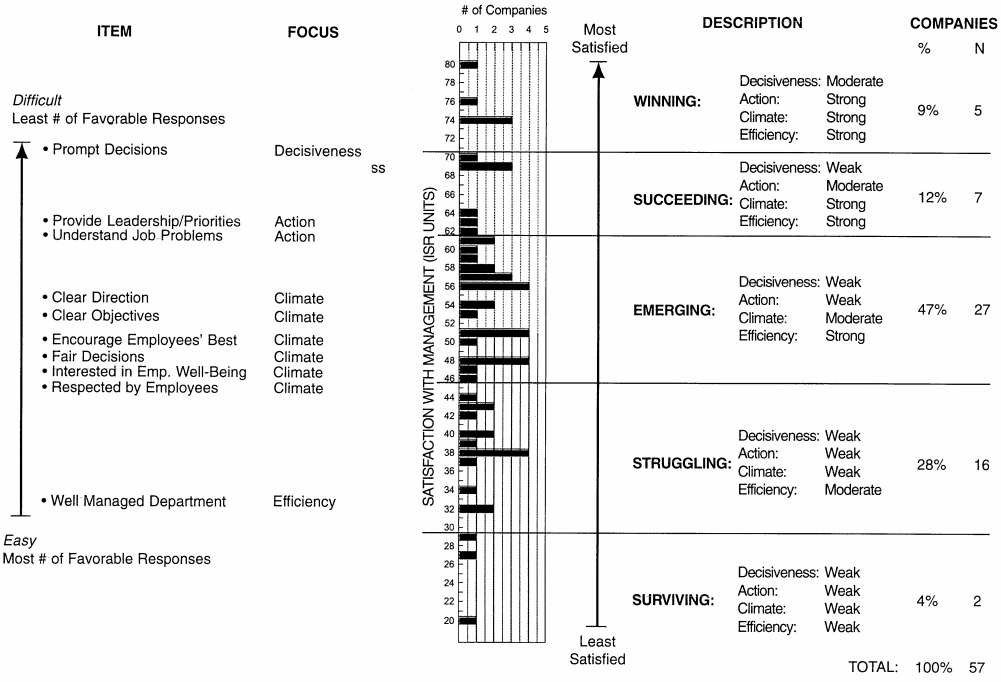Probes on a questionnaire must be worded to elicit from the respondents clear, precise, specific details concerning narrow, probably historical, situations. Presentation of the findings of the questionnaire must be broad summaries designed to be as general and future-action-oriented as possible. Since the purpose for investigating the narrow past is to provide information on which to base decisions in the broad future, the chasm between the particular and the general must be bridged.

In a recent survey we asked employees of major corporations to rate the management leadership climate they experience. The items on the questionnaire were clear and precise. They are summarized in the column labelled ITEM in the Figure. The most frequently acknowledged trait was that the manager had a well managed department, the most rarely that there were prompt decisions. We see a hierarchy of management competencies from the relatively easy to the relatively hard. But these are just a checklist. To think about them, one at a time, is too exhausting and perplexing. We can keep only 4 or 5 details in our short-term memories. There are too many details here. The first step in communication, therefore, is to summarize the construct into a few clear stages. After considerable thought and discussion, this was achieved in the column labelled FOCUS. Managers advance from Efficient, to Concerned (Climate), to Activist, to Decisive. This does not pass judgement on whether the decisions are good, just that the manager has a firm enough grasp of the situation to make prompt decisions.
We now have a theory of management. But how does it relate to the corporations? The bar chart shows the distribution of companies in rescaled logits. At the bottom, around 20, even departmental efficiency has not been achieved. At the top, around 80, managers have surpassed the range of performance probed by the questionnaire. Again, the bar-chart provides too much detail. The fairly uniform spread of corporations must also be summarized. After more thought, we achieved this in the column labelled DESCRIPTION. 5 stages are identified. For companies near the bottom, labelled (JUST) SURVIVING, even routine management tasks are almost too much to handle. At the top, labelled (POTENTIALLY) WINNING, are managers eager to take on new challenges and become world leaders in business.
A mass of complex survey data has been summarized into a mere 9 words. These words tell managers their own performance level and what to focus on next (the construct). The words also tell top executives the status of their corporations and which area to strengthen next. The power and validity of this construct, its interpretation and its use, become obvious as soon as one applies it to one's own corporate situation.
Jack Stanek & Winifred Lopez
International Survey Research, Inc.
Chicago, Illinois
Stanek J., Lopez W. (1996) Explaining Variables. Rasch Measurement Transactions 10:3 p. 518-519.
Explaining variables. Stanek J., Lopez W. … Rasch Measurement Transactions, 1996, 10:3 p. 518-519.
| Forum | Rasch Measurement Forum to discuss any Rasch-related topic |
Go to Top of Page
Go to index of all Rasch Measurement Transactions
AERA members: Join the Rasch Measurement SIG and receive the printed version of RMT
Some back issues of RMT are available as bound volumes
Subscribe to Journal of Applied Measurement
Go to Institute for Objective Measurement Home Page. The Rasch Measurement SIG (AERA) thanks the Institute for Objective Measurement for inviting the publication of Rasch Measurement Transactions on the Institute's website, www.rasch.org.
| Coming Rasch-related Events | |
|---|---|
| Jan. 16 - Feb. 13, 2025, Fri.-Fri. | On-line workshop: Rasch Measurement - Core Topics (E. Smith, Winsteps), www.statistics.com |
| Apr. 8 - Apr. 11, 2026, Wed.-Sat. | National Council for Measurement in Education - Los Angeles, CA, ncme.org/events/2026-annual-meeting |
| Apr. 8 - Apr. 12, 2026, Wed.-Sun. | American Educational Research Association - Los Angeles, CA, www.aera.net/AERA2026 |
| May. 15 - June 12, 2026, Fri.-Fri. | On-line workshop: Rasch Measurement - Core Topics (E. Smith, Winsteps), www.statistics.com |
| June 19 - July 25, 2026, Fri.-Sat. | On-line workshop: Rasch Measurement - Further Topics (E. Smith, Winsteps), www.statistics.com |
The URL of this page is www.rasch.org/rmt/rmt103h.htm
Website: www.rasch.org/rmt/contents.htm